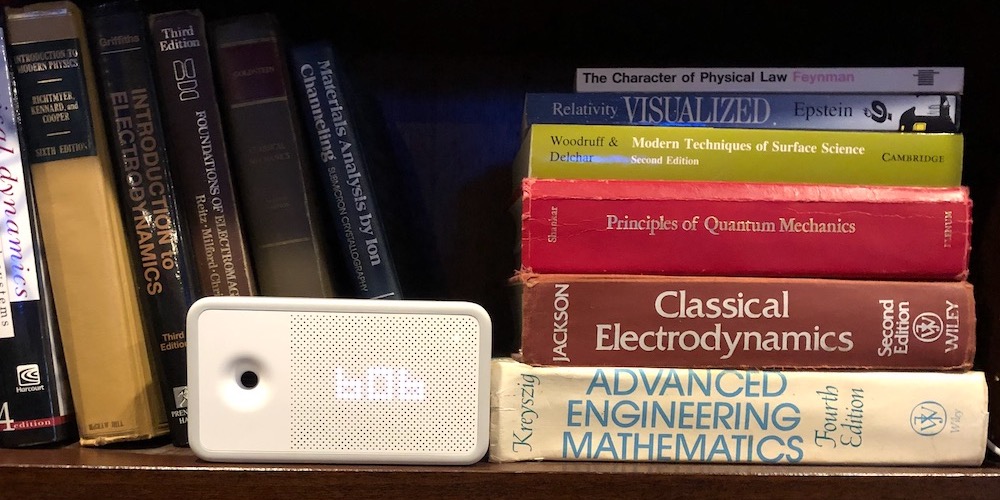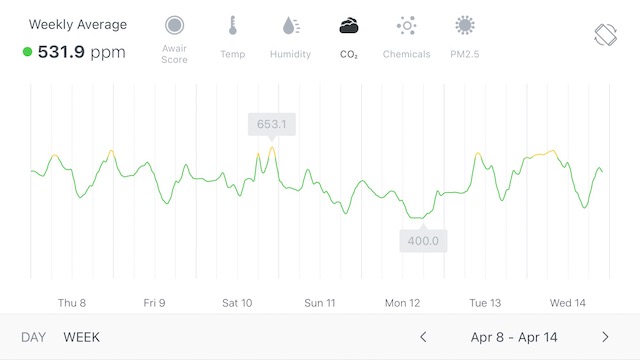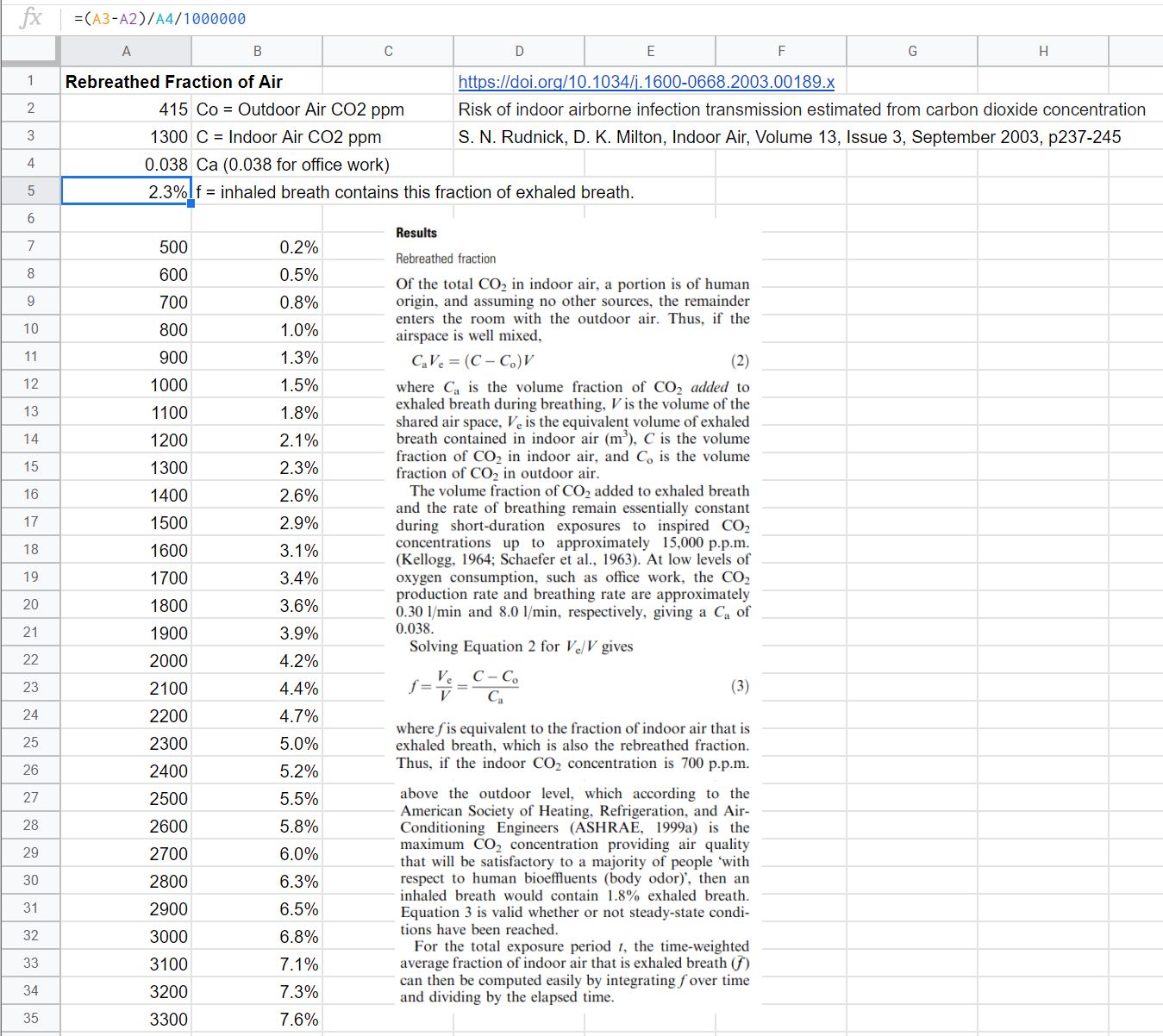Carbon Dioxide and the Air You Rebreathe

You may not want to think about this but every time you inhale, you’re breathing in air that came out of someone else’s lungs. One of my favorite ventilation quotes drives this point home. In a book titled Ventilation and Heating* from 1893, John Shaw Billings wrote:
Most civilized men and women are unwilling to put on underclothing that has just been taken off by another person or to put into their mouths articles of food or drink that have recently been in other people’s mouths but they take without hesitation into their lungs air that has just come from other people’s mouths and lungs or from close contact with their soiled clothing or bodies.
Carbon dioxide to the rescue
How much of each breath you take in is “rebreathed” air? This is where carbon dioxide (CO2) can help. The amount of CO2 in indoor air can be a good indicator of how much air you’re rebreathing. The outdoor CO2 level is about 400 parts per million (ppm). The indoor level is the outdoor level plus whatever accumulates indoors from any carbon dioxide sources there. The two primary CO2 sources indoors are combustion and breathing.
If no one smokes indoors at your house and your combustion appliances, if any, are vented to the outdoors, then your main source of indoor CO2 is people. Our lungs are finely tuned gas exchange organs, taking in oxygen and releasing carbon dioxide. And they do so at a regular rate because CO2 isn’t just a waste product from our metabolism. It’s also used to keep our blood slightly on the alkaline side of the pH scale (7.40 ± 0.05) and that requires not releasing too much or too little. That regularity makes it possible to correlate CO2 level with rebreathed air, which we’ll come to in the last section below. But first, let’s talk about indoor CO2 levels.
Monitoring CO2
Indoor air quality is a much bigger issue than monitoring a single component of the indoor air. Carbon dioxide, however, can play an outsize role in helping to achieve good indoor air quality, especially in regards to COVID-19. Moreover, measuring the CO2 level in indoor environments that you spend time in outside your home can give you an idea of the degree of risk of aerosol transmission of COVID-19 in that space.

I’ve been monitoring the carbon dioxide levels in my home with two Awair Element indoor air quality (IAQ) monitors,* one in the den and another in the master bedroom. The chart above shows the CO2 levels in my den for last week. At the lowest point, our indoor CO2 level was the same as outdoors. This monitor doesn’t read lower than 400 ppm, and the outdoor level doesn’t go much below that these days. The highest CO2 level we experienced that week was 653 ppm. (The resolution of the Awair Element is ± 75 ppm or 10%, so don’t get too hung up on the exact number. And completely ignore the meaningless decimal.)
What’s a bad level of CO2 in the indoor air? ASHRAE, the US EPA, and other IAQ sources say 1,000 ppm is the number you don’t want to exceed. Mainly, the CO2 level is used as a proxy for indoor air quality because it indicates how much air exchange you have between indoors and outdoors. Of course, particulate matter 2.5 microns or smaller (PM2.5) is an important indoor air pollutant that may get worse with more ventilation, so you can’t look at a low CO2 level and assume your IAQ is good. Likewise, you may have really low PM2.5 because of good filtration but high CO2 from poor ventilation.
Let’s focus just on CO2 and ventilation here. Most of your indoor CO2 above 400 ppm is from the people who occupy the space. The chart above shows when my wife and enter the den and spend time there because that’s when the CO2 level rises. When we leave the room, the CO2 level there drops. We never hit 1,000 ppm, which is great, but this is spring and we have some windows open. In winter and summer with the house closed up and no whole-house ventilation system running, CO2 levels go higher. Once I get my new Zehnder ERV installed, I expect to see the CO2 levels stay low even when the house is all closed up.
The rebreathed fraction of your indoor air
David Elfstrom, an engineer in Canada, has been posting a lot on LinkedIn and Twitter about rebreathed air. He even posted a screenshot from a spreadsheet (below) he put together that correlates the indoor CO2 level with the fraction of rebreathed air. Elfstrom used the equations in a paper from 2003 to make the connection.

For low CO2 levels, the amount of rebreathed air you inhale is low. It’s only 0.2% at 500 ppm. By 800 ppm, the highest we’ve seen in our den, the percentage of rebreathed air is up to 1%. By the time you get to 1,500 ppm, 3% of every breath you take is air that was recently exhaled from someone’s lungs.
Note that I didn’t say “someone else’s” lungs because some of that rebreathed air was yours. If you’re one of only two people in the room, about half of the rebreathed fraction would be from you. With four people in the room, now 75% of the rebreathed fraction is from other people. The general conclusion is that the more people are in a room and the higher the CO2 level, the more of other people’s air you’re rebreathing.
Since we know that COVID-19 is spread mainly through aerosols that can float around in the air for hours, the amount of rebreathed air can be a determining factor of your risk for contracting this ailment. If CO2 levels are high, make sure to wear a good mask—or double mask—if you’re around people from outside your household. Otherwise, you might as well exchange underclothing.
Allison Bailes of Atlanta, Georgia, is a speaker, writer, building science consultant, and founder of Energy Vanguard. He is also the author of the Energy Vanguard Blog and is writing a book. You can follow him on Twitter at @EnergyVanguard.
Related Articles
COVID Is Airborne — Are You Feeling Lucky?
Which Indoor Air Pollutants Matter Most?
Can Your HVAC System Filter Out Coronavirus?
* This is an Amazon Associate link. You pay the same price you would pay normally, but Energy Vanguard makes a small commission if you buy after using the link.
NOTE: Comments are moderated. Your comment will not appear below until approved.
This Post Has 12 Comments
Comments are closed.

Great article. I’ve been doing a lot of monitoring of my own IAQ ever since we made our old home substantially tighter (7 ACH50 vs 15 ACH5) and Oregon’s 10 day wildfire event where outdoor AQI was over 500 more often than not. I use an indoor PurpleAir monitor that verifies that our standalone air filters work very well (most often our AQI number is 0) but my C02 monitor shows that our levels are routinely up around 1250 and sometimes even go over 1500. I’ve read alternative sources that suggest the limit for healthy CO2 could be as high as ambient (400-450) plus 800 so that puts us right on that line more often than not. My wife and I are likely going to host other vaccinated people indoors once we receive our second shot but I’m glad we decided not to during the entire pre-vax pandemic period. I’ve been on the fence about investing in a whole home mechanical ventilation system since we’re located next to an autobody shop that paints cars frequently but we’re scared of bringing in chemicals and HEPA filtration on the systems I’m considering is $$$$$
Ryan, great job on keeping the particulates low in your home! The only way to get those CO2 levels down, though, will be with ventilation. I guess you’ve looked at locating the intake on the opposite side of the house from the auto shop? Another option would be to install a ventilation system and run it only at night, assuming they’re closed then.
does anyone have suggestions for the top CO2 handheld (inspection) devices for accuracy/cost, and experience using them?
Dave, the Aranet4 and the HOBO MX1102A are both battery powered and portable. David Elfstrom, whose spreadsheet I showed above, likes the Aranet4. My friend Mike MacFarland in California uses the HOBO logger. I haven’t used either yet but am planning to buy the Aranet4 before too long.
Thanks, Allison. I assume you, like me, need to save a few pennies before buying that. Appreciate the feedback.
I read an article a while ago written by another engineer who had too much time on his hands. He estimated the total number of oxygen atoms in the atmosphere and the total number of oxygen atoms in a person’s breath. The end result was that, with every breath, there is a reasonable chance that you are inhaling at least one atom that was breathed by Julius Caesar in his last breath. Now that’s sharing. FWIW, there is a similar article posted at Futurism for those wishing to see the math.
Peter, yes, that’s been going around for a while. (HaHaHa!) In fact, I just read that thing about Caesar in an article in yesterday’s New York Times. Here’s the link: Where Does a Candle Go When It Burns?
The difference between the spreadhsheet in this article and the statement about breathing in an atom from Caesar’s last breath is time scale. The spreadsheet is all about what happens over minutes and hours; Caesar’s breath is centuries and millennia.
Yes, of course. Both are interesting examples of sharing the air we breathe. Of course the current context is probably more useful to most of us than the Caesar one. I read the Caesar one long ago and it was one of the first to get me thinking about the general idea. I do like the posted spreadsheet as a quantified indicator of the extent of shared aerosols in indoor situations. Kind of disturbing, actually.
We have a 300 gallon saltwater aquarium in our home along with 55g and 20 g “quarantine tanks”. Ideally the pH of a saltwater aquarium is about 8.2, 8.3 and should remain in a tight range. The biggest obstacle to maintaining an alkaline pH in a saltwater aquarium is CO2 in the air. With 2 adults and 2 Golden Retrievers in our fairly large home with all windows closed the CO2 runs about 600-700 ppm in the basement where our aquarium filtration system is located. Being in SC we can open a nearby window several months of the year and get the basement CO2 to less than 500 ppm.
We have noticed on rainy days that the CO2 in the basement shoots up to 1400-1500 ppm. (And we see the pH of the tanks go down.) Based on some internet research I believe the source of the CO2 is microbial activity in the soil. I found an article from a Wisconsin county agent that documented this effect which resulted in the gas water heater pilot light being snuffed out by the high concentration of CO2. As the soil dries out over a couple of days the CO2 returns to the typical level.
We looked into an external ventilation system but there is no way to run an external fresh air source to the basement HVAC due to its location. Well, no REASONABLE way!
Hi Nan,
Your ups and downs in co2 could be part of our plants photosynthesis daily routine ie takes in co2 during the daylight and at night releases 50% of what it captured earlier that day.
Best wishes
Interesting paragraph in many ways. I am a licensed home inspector and find many homes do not have the required slope on the outside grading, 6″/10′-0″. The idea is that water sheds more quickly away from the house keeping the soil more dry that is near the foundation. I wonder if doing this would decrease fungal activity in the ground outside your basement. Do you see moss or algae on the ground? This would decrease water intrusion into your basement. Another source could be fungal activity because of water condensation on the interior surfaces of your masonry basement walls. If that’s the case, you would need to add a dehumidifier to the basement and keep those windows closed (or insulate the exterior surface of your basement walls to keep the masonry warm) This would make the greatest difference when the air is warm and humid and the ground is still cold.
These are currently unavailable Awair Element indoor air quality (IAQ) monitors. Is there another product that you would recommend?
Thank you!